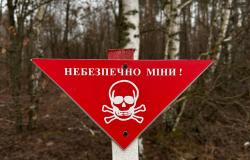The Unravelling of the Ottawa Treaty

Mihail Evans on the forces supporting the worrying retreat from the treaty.
The Ottawa Treaty or to give it its full title, the Convention on the Prohibition of the Use, Stockpiling, Production and Transfer of Anti-Personnel Mines and on their Destruction, was concluded in 1997. The provisions of the Treaty are comprehensive and are notable for a lack of exceptions. It requires that anti-personnel landmines are never used, developed or stockpiled. It necessitates existing minefields be cleared and assistance given to victims.
In June, Mirjana Spoljaric, president of the International Committee of the Red Cross (ICRC), said that the Ottawa Treaty ‘stands as one of the most successful disarmament treaties ever negotiated’. The vast majority of the world’s countries have acceded to the Treaty. By the spring of 2025, there were 133 signatories and 165 parties. It has led to a drop of over 75% in the number of casualties.
From the signing of the first Geneva Convention in mid-nineteenth century, a body of international humanitarian law has been developed which establishes that militaries cannot use any means to achieve their ends. Initially these pioneering agreements were concerned only with combatants but, beginning with the last Geneva Convention signed in the immediate aftermath of the Second World War, a series of instruments also created protections for non-combatants.
In 1977, Additional Protocol I specifically prohibited the indiscriminate use of weapons against civilians. Three years later, Protocol II of the Convention on Certain Conventional Weapons which may be Deemed to be Excessively Injurious or to Have Indiscriminate Effects (CCW) became the first international instrument explicitly governing and controlling the use of anti-personnel mines. However, it did not ban them outright and merely established limitations on their use.
Landmines were first used at scale in the World War II. However, widespread awareness of the threat they pose to civilians only came much later. Countries such as Cambodia, Angola, Afghanistan, and Bosnia emerged from conflicts with vast tracts of land rendered unusable and dangerous due to millions of uncleared mines. Anti-personnel mines not only kill but leave casualties with extremely challenging life changing injuries, generally the loss of one or more limbs.
Because they are persistent, mines affect civilian populations to a unique extent compared to any other form of weaponry. 80% of casualties of mines are non-combatants. Mines might be cheap to deploy but their clean-up is slow, dangerous and expensive. They cost as little as a few dollars to produce but hundreds or even thousands to remove. The US State Department declared a ‘global landmine crisis’ in 1994.
NGOs had by then put anti-personnel mines firmly on the international agenda by highlighting the horror they caused. As Princess Diana, who campaigned against land mines prior to her death, put it ‘mines inflict most of their casualties on people who are trying to meet the elementary needs of life. They strike the wife, or the grandmother, gathering firewood for cooking. They ambush the child sent to collect water for the family’. Through such campaigning the issue became transformed from being seen as primarily a security one to a humanitarian one.
In 1994 the UN General Assembly adopted Resolution 49/75 D, ‘Moratorium on the Export of Anti-Personnel Land-Mines’. However, Cornelio Sommaruga, then President of the International Committee of the Red Cross (ICRC) declared that a ‘worldwide ban on anti-personnel mines’ is ‘the only truly effective solution’. Yet a number of key states were unwilling to impose more extensive restrictions.
The Ottawa Process was a novel initiative, established to allow those states which wanted to make further progress to move forward without waiting for the unanimity required in a UN led negotiation. The final agreement of a text in 1997 was an important achievement for multilateralism. The convention entered into force on 1 March 1999 becoming the quickest major international agreement ever to do so in history. The process pioneered in Ottawa was later used to achieve a similar agreement on cluster munitions in 2008.
To date the USA, Russia and China have notably all failed to ratify. This notwithstanding, it has been argued that the Treaty establishes ‘a powerful international norm against anti-personnel landmines that influences even non-signatory states’. When the majority of the world’s nations have banned anti-personnel mines there is a stigma around their use that affects those who failed to sign. In 2014 the USA banned the production and acquisition of anti-personnel mines and their use outside of the Korean peninsula (a move reversed by Trump in 2020).
Ukraine signed the Ottawa Treaty in 1999. However, since the invasion of 2022, it has suffered the sad fate of becoming the most mined country in the world. Russia, which was never a signatory, has laid mines extensively. As early as the first year of the war Human Rights Watch documented accusations that Ukraine was also using banned mines in contravention of its treaty commitment.
Initially, it denied breaches but by the end of last year, Kyiv was openly accepting deliveries of anti-personnel mines from the USA. Russian minefields are perceived as playing an important role in defeating the 2023 counteroffensive and with Ukraine now on the backfoot, it is contended that it also needs to employ such defensive measures. But to do so is a clear breach of its Ottawa commitments. Under Article 20 of the Convention, a state party engaging in armed conflict is not allowed to withdraw from the treaty before the end of any armed conflict.
Already in 2023 Ukraine saw more casualties from mines than any other country in the world bar Syria. The intense mining of Ukraine poses a threat to civilians that is not just immediate but which will last for decades. Thirty years after the end of hostilities, Bosnia remains blighted by mines.
It is not only Ukraine that is backsliding on its Ottawa commitments. In July 2024 the Lithuanian parliament voted to withdraw from the Ottawa Treaty. This was the start of a domino effect that led to all three Baltic states plus Poland announcing their withdrawal. In March 2025. Finland, the last European state to sign the treaty (in 2012) also followed suit. Parliamentary votes have already taken place and withdrawal will be effective six months after the UN is notified. By the end of 2025 Ottawa will have lost six members.
The Ukraine conflict has started a contagion that risks undermining the Ottawa Treaty and progress in international humanitarian law more generally (Lithunania has also left the 2008 treaty on cluster munitions). The ICRC has said that it was ‘gravely concerned’ by ‘a deeply troubling step backward’. Volker Türk, UN High Commissioner for Human Rights, has argued that ‘adhering to [international humanitarian law treaties] in times of peace only to withdraw from them in times of war or for newly invoked national security considerations seriously undermines the framework of international humanitarian law’.
It has been argued that the decisions to abandon Ottawa are not just wrong in principle, they are practically mistaken. A report commissioned by the ICRC in the run up to the Ottawa Convention, reviewing twenty-six conflicts since the end of WWII, found that landmines were of limited military value. When a bill was introduced to the Estonian Parliament in 2022 proposing its withdrawal from from the treaty, it failed after being opposed by the Ministry of Defence.
Developments in drones during the conflict in Ukraine have been revolutionary for the prosecution of war. They have been extremely effective against both armour and infantry, indeed being a game changer that looks like potentially ending the dominance of the tank on battlefield. Horrific as they are for soldiers to face, drones arguably push anti-personnel mines towards obsolescence. Given they are non-persistent, their use does not effect civilians to the same degree and is thus vastly preferable.
As late as December 2024 the Commander of the Estonian Defence Forces was opposing leaving Ottawa, contending there were more cost effective alternatives, among which drones were particularly identified. In January 2024 the Commander of the Latvian Armed Forces similarly opposed withdrawal from the Ottawa Treaty saying there ‘are far more efficient and modern weapon systems than landmines’.
Given such authoritative statements from the relevant militaries, the abandonment of Ottawa would appear to be a largely politically driven decision taken in a charged atmosphere where public discussion of the threat posed by Russia has lost track of realities.
Withdrawal and violation of Ottawa weakens its credibility, makes universal adherence less likely and erodes the stigma against anti-personnel mines and other weapons that cause unacceptable harm. Five EU members walking away from established international law commitments sends a terrible message to the rest of the world. The UN and the ICRC have already spoken out in an attempt to prevent further unraveling.
The Convention on the Prohibition of the Use, Stockpiling, Production and Transfer of Anti-Personnel Mines and on their Destruction was an important achievement at the international level, a victory for NGOs working together with willing states to achieve significant steps in disarmament. It is tragic that the conflict in Ukraine has resulted in the clock being turned back thirty years with perceived security needs once again trumping humanitarian concerns.
Mihail Evans is a Research Fellow at the Institute for Advanced Studies, New Europe College in Bucharest. He is the author of ‘How the European Union failed to prevent the Ukraine conflict’.
Photo by SN.CHE

